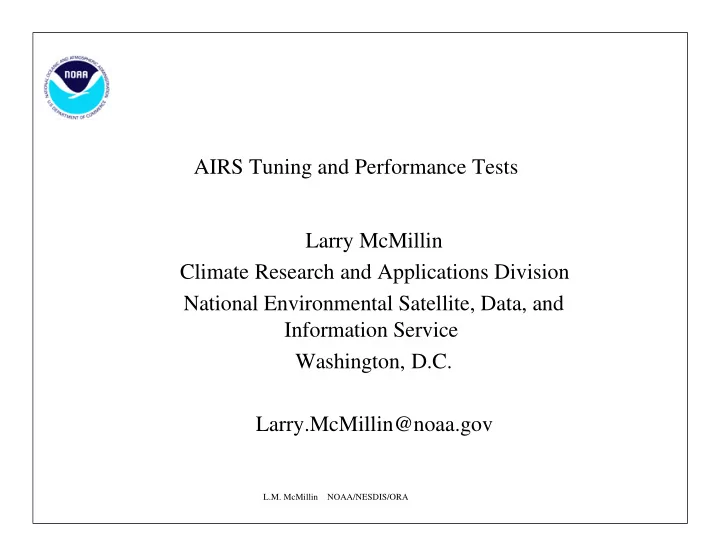

AIRS Tuning and Performance Tests Larry McMillin Climate Research and Applications Division National Environmental Satellite, Data, and Information Service Washington, D.C. Larry.McMillin@noaa.gov L.M. McMillin NOAA/NESDIS/ORA
Microwave Tuning Results AIRS Scan Mirror Coating Test AIRS Tuning Plans L.M. McMillin NOAA/NESDIS/ORA
Microwave Tuning Results • Predict the microwave measured – calculated brightness temperature difference – Uses microwave channels as predictors – Ocean only until land emissivity is checked out • First six slides show the Bias (first three slides) and RMS (corrected and uncorrected) as a function of channel for 3 selected views – 1 side, – 15 middle – 30 side L.M. McMillin NOAA/NESDIS/ORA
L.M. McMillin NOAA/NESDIS/ORA
L.M. McMillin NOAA/NESDIS/ORA
L.M. McMillin NOAA/NESDIS/ORA
L.M. McMillin NOAA/NESDIS/ORA
L.M. McMillin NOAA/NESDIS/ORA
L.M. McMillin NOAA/NESDIS/ORA
Tuning Results Continued • The next 6 slides show – 1. Biases as a function of spot for channels 1 – 10 – 2. Biases as a function of spot for channels 11 – 20 – 3. Uncorrected RMS for channels 1 – 10 – 4. Corrected RMS for channels 1 – 10 – 5. Uncorrected RMS for channels 11 – 20 – 6. Corrected RMS for channels 11 - 20 L.M. McMillin NOAA/NESDIS/ORA
Legend for the next slides • Channels – 1 - blue – 2 - green – 3 - red – 4 - cyan – 5 - magenta – 6 - yellow – 7 - gold – 8 - sky blue – 9 - violet – 10 - yellow - green L.M. McMillin NOAA/NESDIS/ORA
Spot Biases for Channels 1 - 10 L.M. McMillin NOAA/NESDIS/ORA
Spot Biases for Channels 11 - 20 L.M. McMillin NOAA/NESDIS/ORA
Uncorrected RMS Channels for 1 - 10 L.M. McMillin NOAA/NESDIS/ORA
Corrected RMS for Channels 1 – 10 L.M. McMillin NOAA/NESDIS/ORA
Uncorrected RMS for Channels 11 - 20 L.M. McMillin NOAA/NESDIS/ORA
Corrected RMS for Channels 11 - 20 L.M. McMillin NOAA/NESDIS/ORA
AIRS Scan Mirror Coating Test • Procedure – Collect a sample of cold scenes ( < 210 K) • Assumption - no atmospheric absorption in window region – Calculate the average temperature as a function of scan position – Calculate the spot to spot difference for selected spots • Reference is the average of the 2 center spots (45 and 46) • Differences are for spots (5, 15, 25, 35) on one side • and (85, 75, 65, 55) on the other side L.M. McMillin NOAA/NESDIS/ORA
AIRS Scan Mirror Coating Test • Figures show: – The spectral for a typical clear profile – The spot to spot differences as a function of wavelength – The overlap for overlapping detector arrays – The temperature as a function of wavelength for window channels • Note that these channels typically see warm temperatures. – Therefore the effects are greatly reduced for typical earth scenes L.M. McMillin NOAA/NESDIS/ORA
L.M. McMillin NOAA/NESDIS/ORA
L.M. McMillin NOAA/NESDIS/ORA
Tuning – Obtaining the Input • A radiance calculation requires an entire profile – Skin temperature, emissivity, entire profile, and gas concentrations – Radiosondes – most temperatures and water vapor • Missing – surface skin temperature, upper levels, some gases – Forecasts - most temperatures, water vapor, skin temperature, and some gases • Missing – upper atmospheric levels • Sources for the missing information – Forecast – Retrievals – Regression - always available – Models - surface emissivity over water L.M. McMillin NOAA/NESDIS/ORA
AIRS Tuning Plans • Generate tuning coefficients for the AIRS instrument as well as the microwave • Predict the measured – calculated temperature difference • Using – Eigenvectors of the channels + – Solar elevation angle – Latitude? – Other? L.M. McMillin NOAA/NESDIS/ORA
Conclusions • Microwave has a side to side bias • Microwave is biased without the antennae correction as expected - The antennae correction should reduce this • An initial check for a scan position bias due to the mirror coating shows a pattern consistent with the measurements from the GOES witness samples with the same coating but note – Measurements were taken July 20 th at maximum icing and need to be repeated with data after the heating – Effect is dependent on the temperature difference between the scene and the mirror • Earth scenes are warmer so the effect is small for clear measurements • Effect was tested using worse case conditions • Agreement between detector modules that overlap is good L.M. McMillin NOAA/NESDIS/ORA
Recommend
More recommend